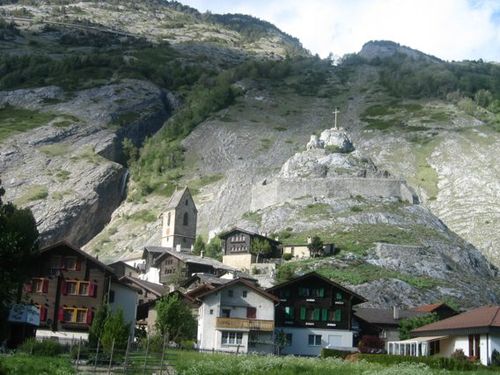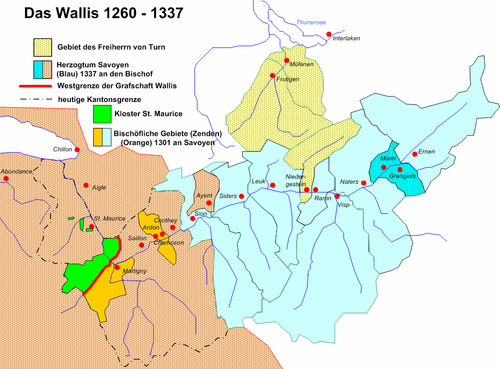Lords of Turn
In the 13th century , the lords of Turn (also: vom Turn ) were among the most important Valais aristocratic families. In the middle of the 12th century, the von Turns were fiefs of the St. Maurice Abbey. It is believed that the von Turn descend from a sideline of the de la Tour family from the Dauphiné . The first known representatives of this sex were around 1170 Wilhelm I and his brother Amadeus, who was Bishop of Sitten . Around this time, Wilhelm I replaced Knight Anselm von Châtillon as fiefdom holder in Niedergesteln. Anselm is appointed by Wilhelm as his Kastlan in Niedergesteln.
The Gestelnburg was probably built or at least expanded by Wilhelm I around 1170. From then on, Gestelnburg was the ancestral home of the von Turn family .
The von Turn family dynasty
The years in brackets roughly describe the period of reign of the barons.
- Wilhelm I (approx. 1170–1196)
- Aymon I. (1196-1226)
- Peter I (1226-1233)
- Girold I. (1233-1265)
- Aymon II (1265-1276)
- Peter II (1276-1308)
- Johann I (1308-1324)
- Peter III (1324-1356)
- Anton (1356–1375) last representative of the von Turn in Valais.
Rise and fall
The von Turns were the richest landlords in the county of Valais alongside the Prince-Bishop of Sitten . Like the bishop, they were directly subordinate to the empire and were therefore directly subordinate to the emperor of the Holy Roman Empire, which is why they called themselves barons. The territory of the barons included parts of today's district west of Raron in Valais and the areas Kandertal, Mülenen and Adelboden in the Bernese Oberland.
With the help of the House of Savoy , the Barons von Turn tried to expand their power in the Valais.
The Valais was heavily devastated by various power struggles and wars that lasted from 1260 to 1297.
In 1296, the landed gentry under Peter von Turn, with the help of the Savoy, stood against the bishop in the battle of Leuk , who was supported by his compatriots and the city of Bern . The landed gentry was beaten and had to give up their compatriots (peasants) rights. The situation between the Savoy and the Valais relaxed for some time.
In 1351 Peter III. von Turn disagreed with Witschard Tavelli , the bishop of Sitten, and allied himself with the barons of Raron and Aniviers. As supporters of the bishop, members of the Peters III family. murdered in Visp and pillaged and plundered their possessions in Niedergesteln and Lötschen , the people of the upper ten, Goms , Brig , Visp , Raron and Leuk rose against the bishop.
This found an ally in Count Amadeus VI. of Savoy , called the "green count". After the cities of Sion and Leuk were occupied without a fight in 1352, the green count entered into negotiations with the Valais, who recognized him.
In 1353 the upper toes rose again against the bishop and conquered morals. The Savoy moved again to the Valais, besieged the city of Sion and burned it down. After disputes and several fights in the following years, the Valais recognized the Count of Savoy and calm returned.
In 1375, followers of Anton von Turn (son of Peter III) murdered Bishop Tavelli von Sitten at his castle Seta near Sitten. The upper toes now rose against Anton von Turn, who fled with his family to Savoy. The Count of Savoy bought Anton von Turn's goods in the Valais, which ended the rule of the von Turn family in the Valais. Anton sold his estate in the Bernese Oberland, the Frutigen estate , to the city of Bern in 1400 .

See also
literature
- Christian Fux: Visp. A portrait in variations. Rotten-Verlag, Visp 2005 ISBN 3-907624-90-4 .
- Marie José: The House of Savoy. From the origins to the red count. Pro Castellione Foundation, Niedergesteln 1994.
- Peter Jossen: barons, counts, priors, people. Rotten-Verlag, Visp 2007 ISBN 978-3-905756-13-5 .
- HLS: "vom Turn" [1]

